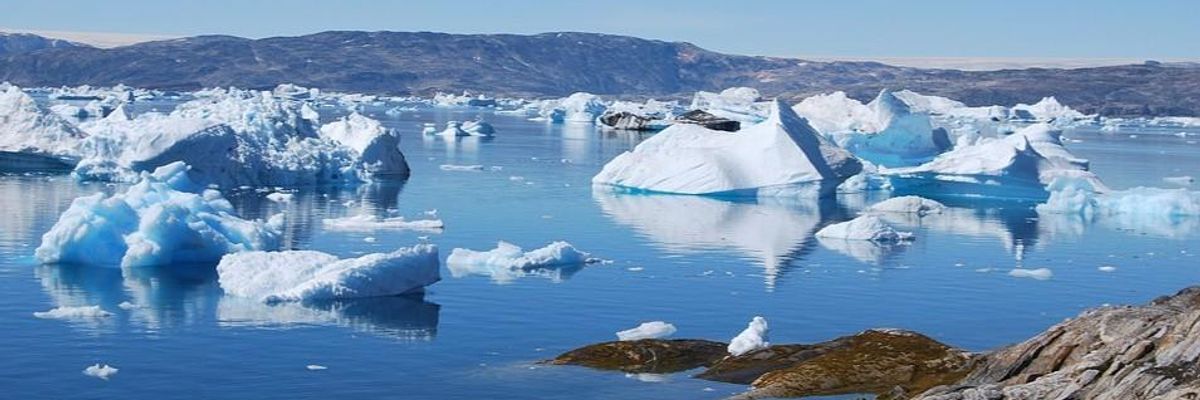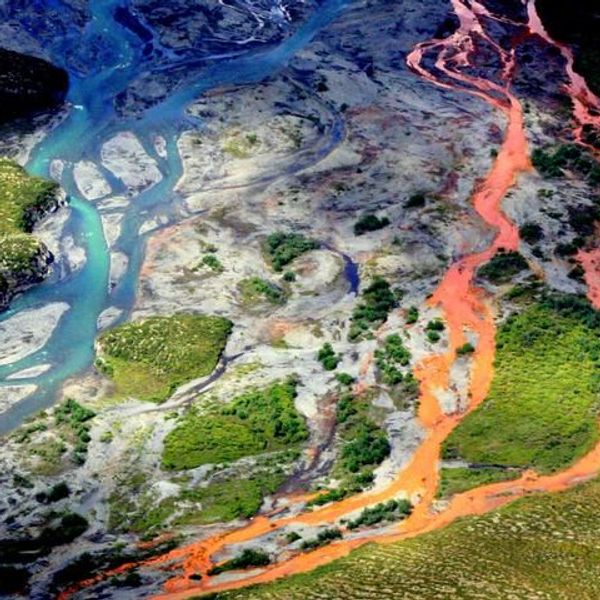
Sea level rise from the current rate of ice sheet melt in Antarctica and Greenland present "worst-case climate change scenario," researchers say. (Photo: Jadeo/Pixabay)
'Worst-Case Scenario' of Melting Ice and Sea Level Rise Coming to Pass, Warn Researchers
At its current rate, the sea level rise will be "enough to double the frequency of storm-surge flooding in many of the world's largest coastal cities" by the end of the century.
The lives and homes of sixteen million people living in coastal areas around the world could be threatened by the current rate of ice-melt in Antarctica and Greenland, which tracks with the "worst-case scenario" put forward by global scientists.
Researchers at the University of Leeds in the United Kingdom and the Danish Meteorological Institute released a study this week showing that the scenario the Intergovernmental Panel on Climate Change has warned about is coming true as the melting of ice has accelerated in recent years, with sea levels rising 1.8 centimeters or 0.7 inches since the 1990s.
"The rate at which they are melting has accelerated faster than we could have imagined."
--Dr. Tom Slater, University of Leeds
Over the last five years, the study shows, melting ice has overtaken thermal expansion--in which the volume of sea water grows as it gets warmer--as the primary driver of sea level rise.
The alarming findings of the study, published Monday in Nature Climate Change, follows research published by Ohio State University last month, which showed that Greenland's ice melt has passed the "point of no return," and even redoubled efforts to stop the warming of the globe by ending fossil fuel extraction will not be enough to stem looming catastrophe.
If Greenland's ice sheet were to disintegrate entirely, the study published this week said, sea levels would rise more than 22 feet.
The loss of Antarctica would cause sea levels to rise 190 feet.
The complete loss of the two ice masses is not currently anticipated by scientists, but the current melting rate could add 17 centimeters, or more than six inches, to sea levels by the end of the century.
"Although we anticipated the ice sheets would lose increasing amounts of ice in response to the warming of the oceans and atmosphere, the rate at which they are melting has accelerated faster than we could have imagined," said Dr. Tom Slater, lead author of the study.
The expected sea level rise has significant implications for coastal cities and towns around the world, the authors said, and humanity is currently "in danger of being unprepared" for the impacts.
The effects of the current rate of ice-melt could be "calamitous" even in the next two decades, tweeted climate campaigner Ben See in response to the study.
\u201cThe melting of ice sheets in Greenland and Antarctica "is overtaking the climate models we use to guide us, and we are in danger of being unprepared for the risks posed by sea level rise."\n\nThere's a risk of calamitous sea level rise of 0.5m by the 2040s.https://t.co/nsigFrQbSq\u201d— Ben See (@Ben See) 1598895425
The expected change in sea levels by the end of the century would be "enough to double the frequency of storm-surge flooding in many of the world's largest coastal cities," said Dr. Anna Hogg, co-author of the study.
An Urgent Message From Our Co-Founder
Dear Common Dreams reader, The U.S. is on a fast track to authoritarianism like nothing I've ever seen. Meanwhile, corporate news outlets are utterly capitulating to Trump, twisting their coverage to avoid drawing his ire while lining up to stuff cash in his pockets. That's why I believe that Common Dreams is doing the best and most consequential reporting that we've ever done. Our small but mighty team is a progressive reporting powerhouse, covering the news every day that the corporate media never will. Our mission has always been simple: To inform. To inspire. And to ignite change for the common good. Now here's the key piece that I want all our readers to understand: None of this would be possible without your financial support. That's not just some fundraising cliche. It's the absolute and literal truth. We don't accept corporate advertising and never will. We don't have a paywall because we don't think people should be blocked from critical news based on their ability to pay. Everything we do is funded by the donations of readers like you. Will you donate now to help power the nonprofit, independent reporting of Common Dreams? Thank you for being a vital member of our community. Together, we can keep independent journalism alive when it’s needed most. - Craig Brown, Co-founder |
The lives and homes of sixteen million people living in coastal areas around the world could be threatened by the current rate of ice-melt in Antarctica and Greenland, which tracks with the "worst-case scenario" put forward by global scientists.
Researchers at the University of Leeds in the United Kingdom and the Danish Meteorological Institute released a study this week showing that the scenario the Intergovernmental Panel on Climate Change has warned about is coming true as the melting of ice has accelerated in recent years, with sea levels rising 1.8 centimeters or 0.7 inches since the 1990s.
"The rate at which they are melting has accelerated faster than we could have imagined."
--Dr. Tom Slater, University of Leeds
Over the last five years, the study shows, melting ice has overtaken thermal expansion--in which the volume of sea water grows as it gets warmer--as the primary driver of sea level rise.
The alarming findings of the study, published Monday in Nature Climate Change, follows research published by Ohio State University last month, which showed that Greenland's ice melt has passed the "point of no return," and even redoubled efforts to stop the warming of the globe by ending fossil fuel extraction will not be enough to stem looming catastrophe.
If Greenland's ice sheet were to disintegrate entirely, the study published this week said, sea levels would rise more than 22 feet.
The loss of Antarctica would cause sea levels to rise 190 feet.
The complete loss of the two ice masses is not currently anticipated by scientists, but the current melting rate could add 17 centimeters, or more than six inches, to sea levels by the end of the century.
"Although we anticipated the ice sheets would lose increasing amounts of ice in response to the warming of the oceans and atmosphere, the rate at which they are melting has accelerated faster than we could have imagined," said Dr. Tom Slater, lead author of the study.
The expected sea level rise has significant implications for coastal cities and towns around the world, the authors said, and humanity is currently "in danger of being unprepared" for the impacts.
The effects of the current rate of ice-melt could be "calamitous" even in the next two decades, tweeted climate campaigner Ben See in response to the study.
\u201cThe melting of ice sheets in Greenland and Antarctica "is overtaking the climate models we use to guide us, and we are in danger of being unprepared for the risks posed by sea level rise."\n\nThere's a risk of calamitous sea level rise of 0.5m by the 2040s.https://t.co/nsigFrQbSq\u201d— Ben See (@Ben See) 1598895425
The expected change in sea levels by the end of the century would be "enough to double the frequency of storm-surge flooding in many of the world's largest coastal cities," said Dr. Anna Hogg, co-author of the study.
The lives and homes of sixteen million people living in coastal areas around the world could be threatened by the current rate of ice-melt in Antarctica and Greenland, which tracks with the "worst-case scenario" put forward by global scientists.
Researchers at the University of Leeds in the United Kingdom and the Danish Meteorological Institute released a study this week showing that the scenario the Intergovernmental Panel on Climate Change has warned about is coming true as the melting of ice has accelerated in recent years, with sea levels rising 1.8 centimeters or 0.7 inches since the 1990s.
"The rate at which they are melting has accelerated faster than we could have imagined."
--Dr. Tom Slater, University of Leeds
Over the last five years, the study shows, melting ice has overtaken thermal expansion--in which the volume of sea water grows as it gets warmer--as the primary driver of sea level rise.
The alarming findings of the study, published Monday in Nature Climate Change, follows research published by Ohio State University last month, which showed that Greenland's ice melt has passed the "point of no return," and even redoubled efforts to stop the warming of the globe by ending fossil fuel extraction will not be enough to stem looming catastrophe.
If Greenland's ice sheet were to disintegrate entirely, the study published this week said, sea levels would rise more than 22 feet.
The loss of Antarctica would cause sea levels to rise 190 feet.
The complete loss of the two ice masses is not currently anticipated by scientists, but the current melting rate could add 17 centimeters, or more than six inches, to sea levels by the end of the century.
"Although we anticipated the ice sheets would lose increasing amounts of ice in response to the warming of the oceans and atmosphere, the rate at which they are melting has accelerated faster than we could have imagined," said Dr. Tom Slater, lead author of the study.
The expected sea level rise has significant implications for coastal cities and towns around the world, the authors said, and humanity is currently "in danger of being unprepared" for the impacts.
The effects of the current rate of ice-melt could be "calamitous" even in the next two decades, tweeted climate campaigner Ben See in response to the study.
\u201cThe melting of ice sheets in Greenland and Antarctica "is overtaking the climate models we use to guide us, and we are in danger of being unprepared for the risks posed by sea level rise."\n\nThere's a risk of calamitous sea level rise of 0.5m by the 2040s.https://t.co/nsigFrQbSq\u201d— Ben See (@Ben See) 1598895425
The expected change in sea levels by the end of the century would be "enough to double the frequency of storm-surge flooding in many of the world's largest coastal cities," said Dr. Anna Hogg, co-author of the study.

